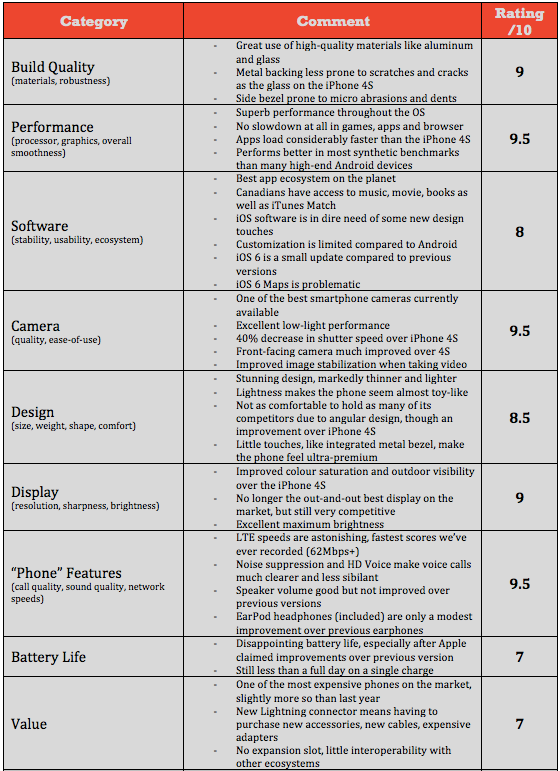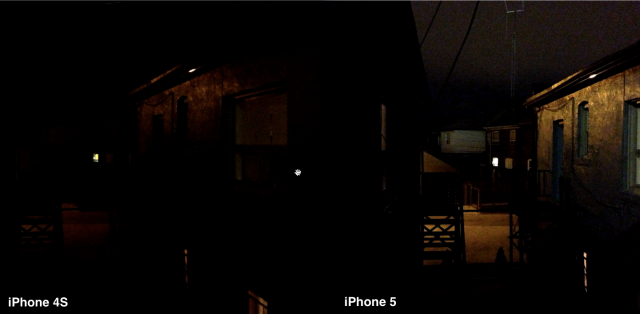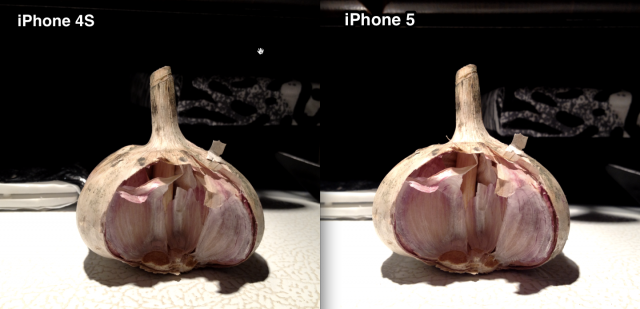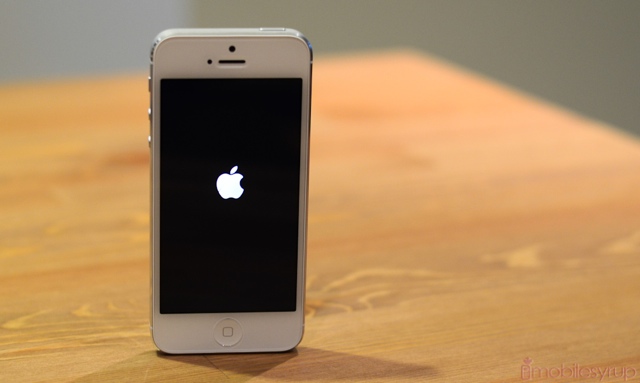
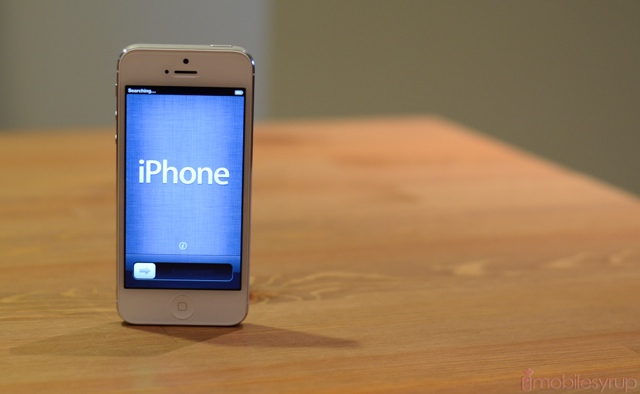
There isn’t much to say about a new iPhone. In many ways, I could finish this review right now, as you’ve likely already made up your mind whether to buy one.
“If you like Apple products,” I’d say, “and you have the money, there is no reason to hold off. It’s a thinner, faster, better iPhone.” But then I’d caution you, too: “But don’t rush into the purchase. As opposed to last year, there are some real contenders out there. Android has picked up its game considerably, and then there’s the promise of Windows Phone 8 and BlackBerry 10. What’s the hurry?”
The iPhone 5 is really the most iterative device Apple has ever released. It has no significant bump in camera quality, nor a new higher screen density, nor a considerably faster software experience (though that may change as apps are updated to support the new processor). There are two kinds of users this review will be tailored towards: those who already use and iPhone, and those who do not. In those two camps, there are those with older iPhones — 3GS and 4 — and those with the newer 4S. To users of Androids, Windows Phones or BlackBerries, it come as a shock to hear this, but Apple doesn’t need your business. They’d love to have it, but the most profitable company in the world is happy to sell its wares to millions of others who just want a phone to work, and work well.
Before we get into the heart of the argument, there are other things to discuss, like the iPhone 5 itself. Is it the phone to lure you out of smartphone fatigue? Let’s take a gander.
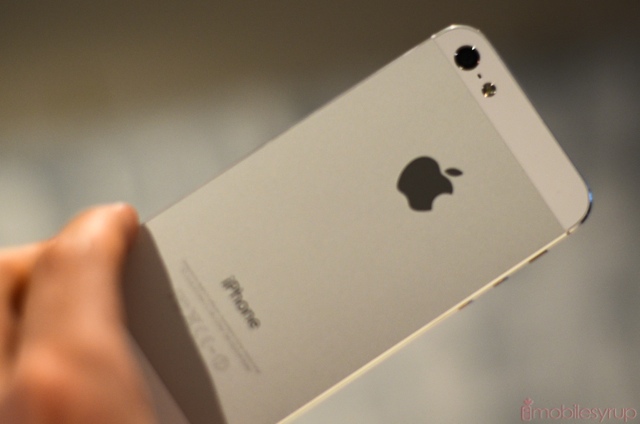
Design & Screen
The iPhone 5 is all about refinement. Whereas the 4 and 4S were huge leaps from the previous generation, eschewing plastic and chrome for stainless steel and glass, the iPhone 5 takes the well-worn design of its immediately predecessors and chisels away at the excess. The metal band that wound itself so separately around the glass frame is now wholly integrated into the iPhone 5 body, with chamfered, sloping edges that promise a mirror finish.
The precision at which these edges are cut is preposterous: Apple claims that each iPhone is fashioned to micron-level exactness, and the resulting feel in the hand is indeed superior to the 4S. Another reason for this is the weight: at 112g, it is 28g lighter than the 4S despite being taller by half an inch. Indeed, the iPhone 5 feels almost toy-like when you first pick it up; it’s only upon closely examining the confluence of its parts do you get an understanding of how minimal it all is. Apple has stripped away every millimetre of excess, culminating in the most pristine smartphone they’ve ever made.
It’s also more comfortable to hold than the iPhone 4 and 4S, largely due to the consolidation of the metal band into the base of the phone. No more scraping your thumb against sharp edges. Its lightness also brings longer usability without fatigue; the phone practically disappears when you hold it to your ear.
But we’d be remiss not to mention how it compares to other high-end devices. The Samsung Galaxy S III, ostensibly the iPhone’s biggest competition at the moment, feels more comfortable to cradle in one hand; its rounded plastic back may not be as aesthetically pleasing, but it provides for a more secure surface to hold. The iPhone’s new metallic back attracts fingerprints and scuffs more so than its legacy glass ever did, and we worry, especially with the black model, that scratches will too show easily.
Other positive changes are less noticeable but equally appreciated. The mute toggle, along with the volume stubs and power button, are slightly more recessed, blending better with the phone’s overall design. The home button, that constant source of mechanical frustration, has a more robust clicking mechanism which will hopefully hold up better over time.
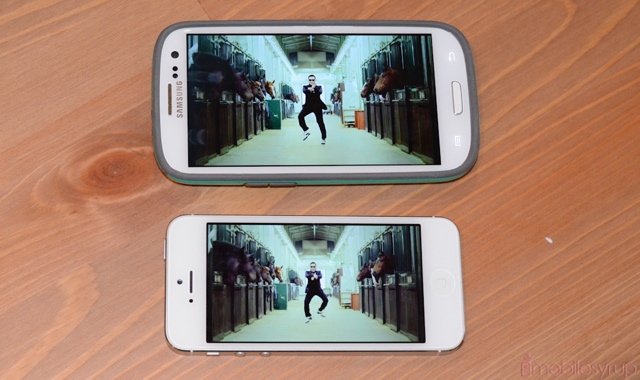
The new 4-inch screen is initially awkward; the 16:9 ratio makes the iPhone 5 look almost comically tall, and takes a while to get used to. Practically, the extra half an inch of screen space is not currently well utilized; the multitasking menu is still only one row of four horizontally-oriented icons, for example. But you can now fit 16 app icons in a folder as opposed to twelve, and the home screen grid has increased to five rows from four. Reading web pages or emails shows more content (obviously) in portrait mode, while watching true widescreen video is more enjoyable as the aspect ratio matches the source.
The pixel density, 326ppi, is unchanged from the iPhone 4 and 4S. This is still one of the best screens on the market, but unlike the 4S, which was miles ahead of most of the competition not only in sharpness but colour saturation, viewing angles and brightness, Android manufacturers caught up to Apple in a big way in 2012. From the HTC One X to the Motorola ATRIX HD, 2012 has been the year of 300+ppi displays, and in some ways there is nothing overly impressive about the Retina display anymore. Yes, the colour saturation is significantly better than on last year’s model, and there is no gap between the glass and the LCD itself, lending it a paper-like quality, but these these accomplishments were awarded to HTC all the way back in April. Instead, the iPhone 5 screen is merely great and competitive, no longer in a class of its own. Oh, how a year can change things.
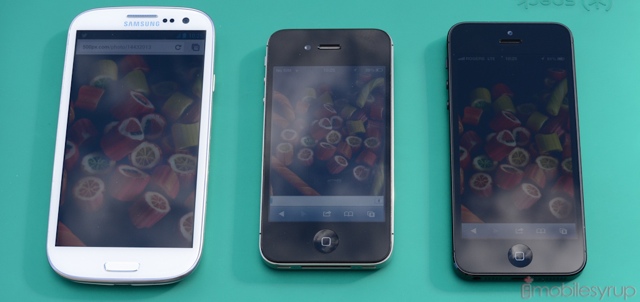
Visibility in sunlight is not significantly improved over the iPhone 4S, though the screen is less prone to glare than its predecessor. Compared to the Galaxy S III, the iPhone 5 does indeed have better colour saturation at full brightness, though the delta is minor. Neither phone could be said to be “usable” in direct sunlight, even at full brightness.
Ultimately, the iPhone 5’s evolutionary design is going to stoke its loudest criticism — that is, until you hold it in your hand. No other company on the planet designs and manufacturers phones with the same minute care and craftsmanship as Apple right now. The iPhone 5 is beautiful equally because of what it has — glass, aluminum, precision — as what it doesn’t have. The company has shed almost every morsel of “flesh” from this body, and what’s left is lean and capable.
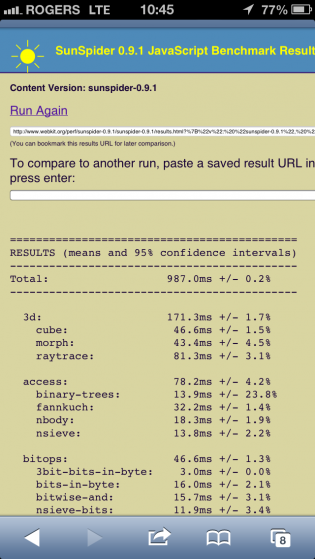

Performance
There is no doubt that this iPhone is significantly faster than the 4S, but it’s difficult to detect how much faster because iOS rarely slows down. Unlike Android, which has benefited greatly from a hardware-accelerated homescreen, iOS has always had this benefit. The foreground task take precedence, and the OS limits what happens in the background. This ensures that, most of the time, the OS performs optimally, consistently and without slowdown.
But the A6 chip inside the iPhone 5 is custom-made by Apple to be extremely powerful, and power-efficient. It posts the best Javascript scores across any device on any platform; its three-core graphics processor is one of the fastest on the market, rivalling and in some cases surpassing the quad-core Exynos 4 processor of the international Samsung Galaxy S III. Apps load noticeably faster, though the 4S was never slow. In other words, the phone feels moderately faster in almost every way. Every way, except one.
Camera shots are now significantly faster than on the 4S. Apple didn’t do it justice when it boasted a 40% increase over its predecessor: the iPhone 5 shutter is practically instantaneous. But again, Android devices have caught up to the iPhone in shutter speed, and the results don’t seem as remarkable as they might if the HTC One X or Samsung Galaxy S III didn’t exist. But they do, and we need to look at other things then to gauge just how much faster the phone is compared to its predecessor.
The biggest bellwether, besides those benchmarks which rarely hone in on real-world performance, is app loading times. Compared to the 4S, the iPhone 5 improves loading times in apps and games by as much as 40%. On games with lots of assets such as high-resolution textures and 3D environments, the difference is very noticeable. Performance inside games is slightly better, but I’d imagine we’ll have to wait a few weeks for games to be released to take advantage of the superior rendering capabilities of the PowerVR SGX543MP3 GPU.
One area that is quizzically not as smooth is typing. The iPhone 5 seems to miss a lot of key presses, though it could be due to the taller screen forcing me to misplace my thumbs. I’ve noticed other users complaining of it, too, so I’m not alone in this complaint.

Camera
The iPhone 5 camera is, simply, amazing. We haven’t had a chance to compare it to the new Lumia 920 just yet, but Apple has made some significant improvements to colour accuracy and noise suppression in its new device.
Low-light photos have received the biggest upgrade here. As you can see, comparing the iPhone 5 to the 4S depicts the same scene with the same external lighting very differently. This is due to some clever processing that produces a slightly smaller image — 4MP as opposed to 8 — in darker locations, and uses the data from multiple pixels to obtain a clearer, brighter image. This process is called interpolation and is the core tenet of Nokia’s PureView 808.
What this means is that despite a slightly smaller file size, shots taken in low light are considerable more usable than on the 4S. Regular daylight shots, or ones taken with the flash, are still excellent, but don’t show the same improvements as the 4S was to the 4. In fact, we’d say that this camera is only slightly better than the 4S in most cases, and is matched by the Galaxy S III and One X in many ways. Except one.
The iPhone 5 takes the best macro shots of any smartphone I’ve ever used. It’s able to easily lock onto a foreground target and capture a shocking amount of detail from that little sensor.
Also significantly improved over last year’s model is the 1080p video. While detail is largely the same as the 4S, image stabilization has been boosted, and the results look less like a smartphone and more like a digital camera. It’s a subtle but desirable effect, and will help amateur videographers create decent material on their smartphone. Again, not a huge improvement over last year, but the iPhone 5 captures the best 1080p video of any device on the market right now. We’ll have to see what the Lumia 920 brings when it’s released later this year.
The iPhone 5 also has better white balance than its predecessor. As you can see from the shot above, the colours are much more accurate; the sensor does not wash out the subtle blues in the middle white area. Greens and yellows are also not as rambunctious; the tones are much more even.
The front-facing camera on the new iPhone is now 1.2MP and can be used to connect to people with FaceTime over the cellular network. Compared to the terrible VGA camera on the 4 and 4S, this is a huge step up, though it likely won’t be used for much else than capturing vanity shots. Let’s be realistic, people.

Software
iOS 6 is neither a significant feature jump from iOS 5, nor is it the staid and boring operating system many people are accusing it of being.
There is no disputing that the iPhone 5 is a gorgeous, well-engineered piece of technology. It’s just so self-contained, sturdy. But iOS looks the same as it did in 2007, and despite an extra row of icons and a few new built-in apps, it seems that the magic has slipped away. There are no drastic introductions here like copy-paste (iOS 3), multitasking (iOS 4), notification centre (iOS 5); this is a clear iterative improvement over its predecessors, and some users will be disappointed by this.
But Apple’s ecosystem is as strong as ever: Siri is much more capable this year than last. Canadians benefit from location services, so you can search for restaurants and landmarks inside many major cities. Siri can open apps, inform you of sports scores, even joke with you. The problem is that there is no way to use the service without voice, and there are many, many places in which voice is no appropriate to use. I’d love to be able to ask Siri a question, say inside Spotlight, and have it spit out an answer to me in written form. Alas, Apple believes voice is triumphant at this point.

And then there is the new Maps application, which is possibly the most divisive addition to the Apple ecosystem in a long time. We’ll likely never know why Apple launched a service so hindered by its own lack of data; it could have saved it for another year and avoided this whole distraction.
Apple has assured us that the Maps application will improve over time. But at this time, its results are infuriatingly inconsistent. At times, and in certain parts of Canada, the information is perfect. We have detailed maps down to the metre for large cities like Toronto. The new turn-by-turn navigation system is amazing, and has never sent me hurtling into the river or even given me an incorrect route. But the lack of transit directions, along with vexingly strange search results, is a very un-Apple realitty. There’s no doubt that the company would have loved to bring a product to market that rivalled, and indeed exceeded, Google’s Maps for quality and beauty on day one. But the reality is that Google has been offering maps, in both desktop and mobile forms, for nearly 10 years. That’s a lot of data that Apple doesn’t have, and they’ve built a fairly robust and feature-complete 1.0 product.
To that end, I spent a lot of time this summer testing out Maps on both an iPhone 4S and, since Friday, an iPhone 5. Until September 19th, with the public release of iOS 6, I was unaware of just how incomplete Apple’s mapping data was. That’s because I only used Apple Maps in big cities — namely New York and Toronto — and their surrounding areas, both of which have been painstakingly detailed by the company. Every address, every nook, I requested location data for was present. Yes, there were some anomalies, but Google Maps also spits out a bad result every once in a while. I’m not trying to defend the product — it’s really, really bad in some areas — but if you live in a big Canadian city like Toronto, Montreal, Vancouver or Calgary, you won’t really miss Google Maps. But bring a backup when you’re traversing through more rural areas — just in case.
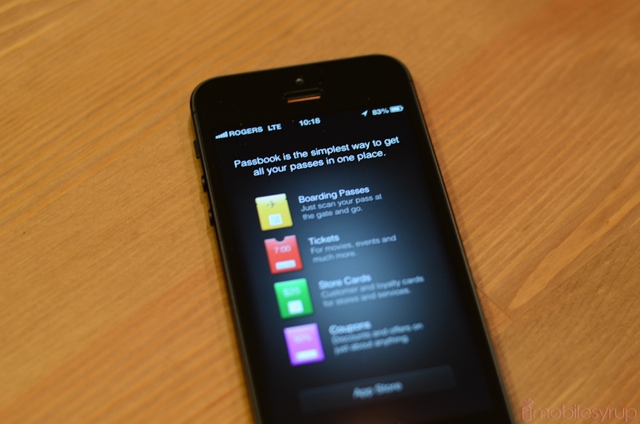
For a long time, through the iOS 6 beta, I thought Passbook was an app, something that Apple was waiting until the final release to turn on. It was explained to me shortly thereafter that Passbook is in fact a portal, a consolidator of passes, tickets, payment services and more. Right now, there are only a few Canadian apps that support it, namely Cineplex and Ticketmaster/Live Nation, but they work quite well. When you pay for something, say a movie ticket, with an app that plugs into Passbook, the ticket with an appropriate barcode will be accessible in the app itself. The location-aware service will detect when you’ve reached your destination (in the case of Cineplex, it knows which theatre you bought your ticket for) and the pass or ticket will appear on your lock screen when you’ve reached your destination.
A year from now, Passbook will be a robust and important portal for mobile payments, NFC or not. Apple clearly doesn’t think NFC is ready for the mass market, opting instead for barcodes and other screen-facing forms of secure payment. Starbucks has been doing this for over a year now, and many other companies are catching on. NFC or not, Apple’s Passbook has potential to be great. The problem is that it may discourage retailers and merchants from implementing NFC-capable payment systems despite the low-power communication technology being present on most modern Android and BlackBerry devices, and all upcoming Windows Phone 8 handsets.
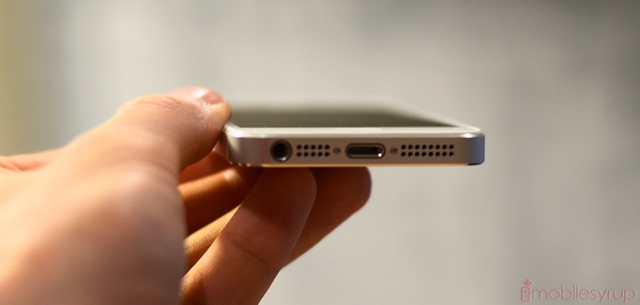
The main problem with iOS 6 isn’t what it can do — because what it does, it does extremely well — but what Apple feels it shouldn’t do. Multitasking is still half-baked, and the number of processes that the phone can perform in the background is severely limited. Yes, that prevents excessive battery drain, but I’d love to be able to leave my house, get on a subway car and have all my RSS feeds updated without having to open it and let it sync beforehand. (And I’m aware there’s a sort-of hack to enable this but I’m talking about true background update support).
At the same time, some of Apple’s “revolutionary” features, such as Siri, are less impressive in 2012 in the face of competition. Google’s Jelly Bean update brought a service called Google Now, and it is in many ways what I’d prefer Siri to be — far more visual, and less reliant on voice. Similarly, the new Panorama feature that Apple touted in its keynote has been available on Android since the introduction of Ice Cream Sandwich last October.
Apple’s advantage comes in its implementation of these features: they are not difficult to use, or to master. But they’re extremely powerful. The panorama feature is much better than Android’s; Siri understands way more semantic language than Google Now. The iPhone 5’s keyboard is more accurate than Google’s Jelly Bean (most of the time). But where are the lock screen widgets? Why can’t we place app icons where we want? Why can’t we clear all notifications at once? Why are the settings for apps buried inside multiple menus? Why can’t I disable WiFi from the notification centre?!
Apple still has a huge advantage when it comes to app quality. As much as I love Android — and I do — there is no question that app design, even in the Holo era, still lags behind Apple. Few, if any, apps are released on Android first, and the iPhone is still a far higher priority for the majority of development houses than Android. This isn’t disputable; it’s a fact.
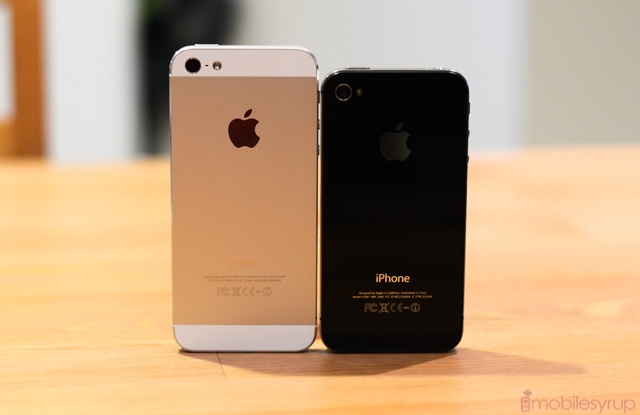
Battery Life
So far, so mediocre. Despite claiming that the iPhone 5 would last longer than its predecessor — eight hours of LTE browsing compared to six hours of 3G browsing on the 4S — I haven’t found any drastic improvements. In fact, the iPhone 5 has been disappointing when it comes to day-to-day usage, often hitting the dreaded 10% mark in less than eight hours.
It’s often difficult to tell whether the poor battery life will improve over time; I’ve found this to be the case with many Android phones. iOS 5, when it was released, was also very hard on the iPhone 4S’ battery, only to improve in subsequent software updates. This could be the case with iOS 6, but there’s no point in making excuses for the phone: I have to review it the way it is upon release.
Considering how heavy on battery LTE tends to be, the iPhone 5 holds up quite well against competing Android phones. Even with a 1440mAh battery the device lasts just an hour or so less than the Galaxy S III, which isn’t a huge endorsement but an achievement nonetheless.
We’ll continue to do battery tests on the iPhone 5 and follow up in a future post.
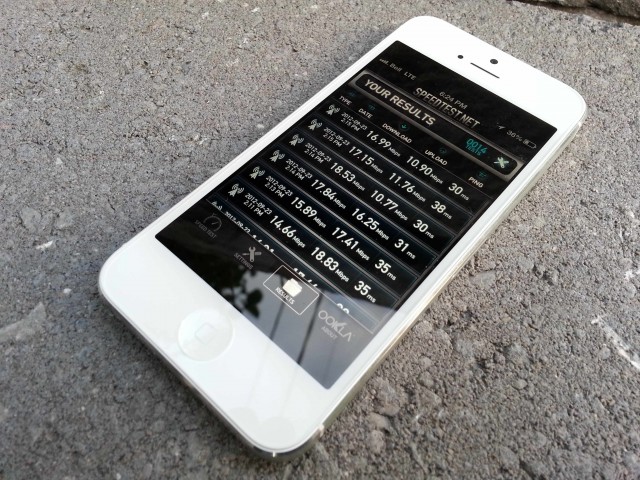
Network Speeds, Call Quality & Other
The Qualcomm baseband inside the iPhone 5 supports dual-channel HSPA+ up to 42Mbps and LTE speeds up to 100Mbps. This is a huge speed bump from the 4S, which tapped out at 14.4Mbps. Using the iPhone 5 over cellular is akin to going from a 14.4kbps baud modem to cable.
My results on both the Bell and Rogers LTE networks were faster than any Android device I’ve used to date. At my house, which usually nets three to four bars of LTE signal, I averaged between 18-55Mbps down and 12-26Mbps up; on Bell’s excellent DC-HSPA+ network I achieved a healthy 12Mbps down and 3Mbps up. This will be the single most noticeable speed bump for users upgrading from an iPhone 4 or 4S. But LTE has been available on various Android and Windows Phones for months now, and we’re used to it. The decreased page load times, quicker app downloads and general sprightliness is a great addition, especially since this will be the first experience with LTE for many people.
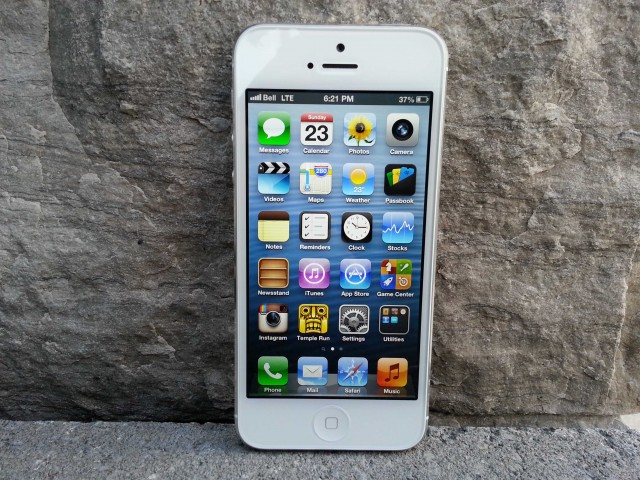
With hundreds of thousands of iPhone 5’s hitting the Canadian streets in the next few weeks, we’re interested to see how the carriers’ networks hold up to the strain. LTE has, until now, been a wide open and largely untested infrastructure. But even slow LTE is faster than the fastest 3G.
One area in which the iPhone 5 is drastically improved is call quality. Over the Bell network (I didn’t try TELUS), which supports HD Voice, the recipient (who must also be using a phone that supports wideband audio) sounds pin-drop clear, a dramatic improvement over the 4S. Noise suppression is also better than on previous models, even without HD Voice. Callers on the other end of the line found our voices clearer and more easily understood in noisy areas.

Then there’s the Lightning connector, which replaces the well-worn and wide 30-pin we’ve gotten so used to since 2003. Not being able to use any of your previous accessories may be a maddening consequence of progress, but like most other iPhone 5 owners, I recognize the inevitability of it. First, it’s smaller — much, much smaller — and is reversible, so you’ll never have to worry about breaking your phone after drunkenly assuming the cord goes in the other way.
But the reality of the situation is that there are hundreds of millions of Apple products out there, and millions more accessories, that are suddenly all-but-obsolete. My external battery chargers, docks, cases and car adapters — useless. Buying new ones is a cost one must consider when purchasing the new iPhone. It’s not cheap, but you can rest assured that this Lightning connector will stick around for at least another nine years.
That fact that replacement cables are $21, and the cheapest Lightning to 30-pin adapter is $35, is ridiculous. Apple should be making the transition easier for its customer base, but that’s just my opinion.

Conclusion
This was a long review to say very little. Ultimately, I’m not going to be the one to convince you to buy an iPhone 5. Our readers are a diverse and largely divided group of Apple lovers and haters, and it doesn’t matter what the company puts out because its reputation precedes it.
But try to leave alone the Apple legacy for a moment and compare it to other devices on the market. While the iPhone 5 may not be the fundamental do-over that many people wanted, from either a hardware or software perspective, it stands on its own as a very competitive, and compelling, product. It’s better built than the vast majority of its competition, and though that competition has caught up to Apple in many ways in 2012, from both a hardware perspective (HTC, Motorola) and a software perspective (Google, Microsoft), the iOS ecosystem is still without rival. App quality and access to music and movie downloads cannot be overstated; there is no Kindle Fire in Canada, and try finding an equivalent service to iTunes Match from Google.

The iPhone 5 improves upon its predecessor in every possible way. There isn’t a single aspect of the 4S that isn’t in some way bettered by the 5. But it’s not a reinvention, nor a marked departure. Apple is on cruise control, and they know that millions of customers don’t care. For Canadians upgrading to the iPhone 5, many will have just come off three-year contracts from the 2009, when the iPhone 3GS was the best smartphone money could buy. To them, and owners of the iPhone 4, I’d say pick up an iPhone 5. It’s a huge upgrade, and definitely worth signing a new contract for. Many iOS 6 features such as turn-by-turn navigation, Flyover mode, Siri, Panorama, and Shared Photo Streams, are only available on the 4S and the 5.
iPhone 4S owners don’t need to upgrade. That phone is still blazingly fast, and there isn’t a single feature on the iPhone 5 that isn’t available on the 4S. The increased screen space is nice, but not a game-changer. The 4S didn’t become thick or shoddily-made overnight. It’s still a fantastic smartphone. It’s really LTE speeds that are going to bring you over to the fold, if you aren’t yet decided. That’s the single biggest benefit to using an iPhone 5 at the moment.
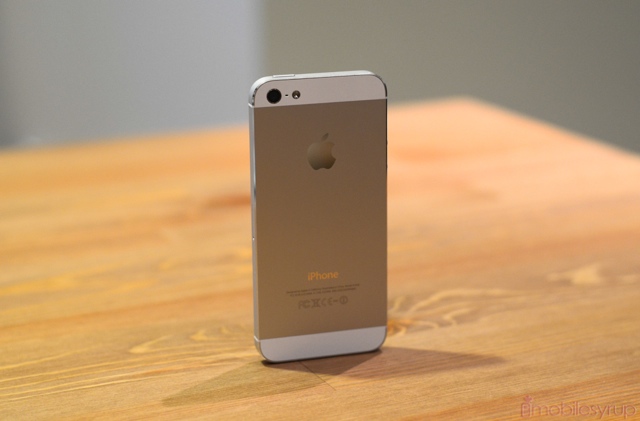
I have no qualms in saying that the iPhone 5 is one of the best smartphones on the market today. It may be expensive — it starts at $179 for a 16GB model — but it’s worth it. That Apple has fiercer competition this year in Samsung, HTC, Nokia and Motorola and others does not discount the significance of this upgrade. I am happy to call an Android phone, or a Windows Phone, or a BlackBerry for that matter, the best smartphone out there. I try every one of them, and love or hate them according to their abilities, not whose name is on the box.
But the iPhone 5 is not the best smartphone on the market; the competition continues to bring its A-game. With devices like the LG Optimus G, Samsung’s Galaxy Note 2, Nokia’s Lumia 920, Sony’s Xperia T and HTC’s 8X coming out in the coming months, it’s a good time to be a smartphone user.
